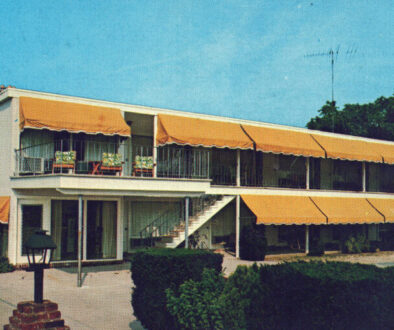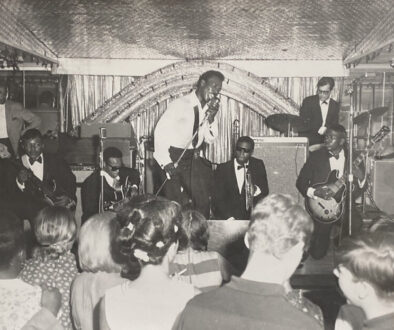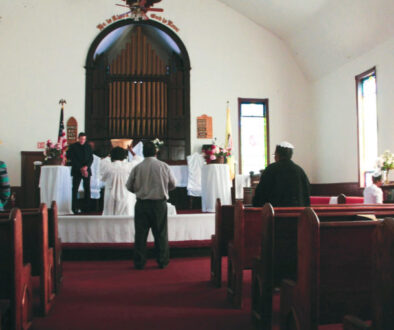To Worship & Preserve
“In August of 1892, the religious society and congregation of Colored Baptist[s] living in the City of Cape May met for the purpose of organizing a Colored Baptist Church. These assemblies of believers were recognized by the West New Jersey Association, and on Dec. 23, 1895, the Macedonia Baptist Church was duly named, certified and recorded.”
-Excerpt from the church’s original incorporation papers
The Macedonia Baptist Church congregation still meets today, in its church built at the beginning of the 20th century on the corner of Lafayette and Franklin Streets. This neighborhood of a few square blocks contains most of Cape May’s civic institutions, and was the core of the city’s African-American society for much of the 20th century. The Franklin Street School, the African Methodist Episcopal Church, as well as the former Franklin Street Methodist Church—all traditional African-American institutions—are within a block of Macedonia’s building.
The church sold a rear parcel of its land to the city of Cape May, which built the Franklin Street School, opened in 1928 for African-American elementary children. It is now preserved and under restoration by the Center for Community Arts.
Next to the church, on Lafayette Street, stands one of Cape May’s oldest houses, predating the Great Fire of 1878 that destroyed so much property that rebuilding resulted in the city’s unique collection of late Victorian structures. Howell House was built in 1850; its current Gothic Revival appearance is the result of later additions, according to a written report by architect Hugh J. McCauley of Preservation New Jersey, who has researched the building’s history and presented justification for its preservation and restoration.
The house has belonged to the Macedonia congregation since 1909, when its owner, Philadelphia merchant George Howell, donated it and the adjacent lot to the congregation. “The congregation constructed a new church building on the adjacent lot and the Howell House became their parish house,” says McCauley’s documentation. “This wood frame vernacular house is a contributing resource to the Cape May National Historic Landmark district.” Cape May’s Historic Preservation Commission defines contributing structures as “those whose architecture enhances the neighborhood where they are located but the style is not unique.”
Ministers lived in Howell House until about 30 years ago; since then the building has been neglected and fallen into serious disrepair. Many residents of Cape May remember when the asphalt siding was removed a few years ago, revealing strong structural bones, despite the faded clapboards and sagging porch. At one time the congregation considered selling the building to a developer. The deal was not approved, but the developer “entered the building and gutted the interior,” anyway, according to McCauley’s report. That prompted the congregation’s decision to consult an architect and eventually secure the property and repair the porch. Now the house is surrounded by a protective fence while the Macedonia congregation raises the funds necessary to restore it.
Lois Smith, a lifelong member of the congregation, remembers sprucing up the house in the 1940s when Reverend Richard Jones was about to move in. “My godfather, Archie Robinson, cleaned the outside and the grounds, and the ladies worked inside—my mother and I and another lady,” and at her mother’s suggestion, the three of them painted the interior.
Reverend Kathleen Smallwood Johnson, called Pastor Kathy by congregants, became Macedonia’s pastor in 2012. She shares a vision for the building: a Victorian style tea room, Christian reading room and gift shop; a place for meetings and study; and living quarters upstairs. Yes, Pastor Kathy plans to move in, once she has retired from her other job with the Trenton Board of Education.
Reverend Johnson is the 13th pastor to serve the Macedonia congregation. The first was Reverend B.S. Ryland, in 1911; the longest serving was Reverend Robert O. Davis, who ministered from 1963 to 2009. His retirement coincided with the church’s 100th anniversary celebration, attended by hundreds of local residents at Cape May’s Grand Hotel ballroom. He was the last minister to live in Howell House, having spent 20 years there with his family.
Reverend Johnson came to Macedonia in March of 2012, after a few years of interim ministers following the retirement of Reverend Davis. She met long-time Macedonia congregant Daniel Money at a conference, and when he learned she’s a preacher, invited her to speak at Palm Sunday services in 2011. She added the Easter service that year, came back several times, and was formally installed the following spring.
“God has a sense of humor,” she says. “I came from a church with 7,000 members and three services every Sunday” to this congregation, that varies from 30 or 40 members in winter to about 125 in summer, except for “special occasions” that bring in 150 to 200.
She points to the opposite experience: Reverend Jones, who served in the 1940s, moved to a church in Burlington County and built a congregation of 2,000 to 3,000 people. ”I didn’t feel led to do that. On the other hand, if Reverend Jones could do it in Burlington, maybe I can do it in Cape May.”
The congregation has appointed a Historical Coalition Committee that has taken responsibility for collecting, resurrecting, and preserving the history of the church. Members Lois Smith; Dr. Mary Jane Lupton; Mrs. Jacqueline Hotan and her husband Lawrence; Peggy Ose; Kathleen Matthews; and Diane Mitchell are delving into documents about baptisms and other ceremonies; history of the buildings; various clubs and activities over the years, and the progress and contributions that families have made over the years, says Lois Smith, chair of the committee and lifelong member of the Macedonia congregation. They won’t be ready to reveal their findings for some time, she says, because everything they learn will be confirmed. They hope to have a book completed by the end of the year.
Howell House, as all can see, needs work, but so does the church—a 100-year-old building is going to have a few issues. The church roof was in worse shape than the one on the old parsonage, says Reverend Johnson, so it’s been fixed. The embossed and decorated ceiling needs restoring, and there are cracks in the foundation. When Reverend Johnson first took a good look at the church building three years ago, she said, she was reminded of Sleeping Beauty’s castle, with vines overrunning everywhere. “Can we just put a coat of paint on it?” she asked. They did—the vines are down, and their ghosts have disappeared under fresh white paint. Soon after, flower boxes appeared on the fence, and planters decorated the front lawn—all supervised by congregant Kathleen Matthews, who loves to garden and is now the church’s designated “master gardener.” Weekly breakfasts, and occasional barbecues and dinners, several other fundraising events, and partnerships with community businesses and organizations have raised a building fund that stands at $25,000 and growing. Anonymous donations and regular contributions from friends everywhere continue to build the financing required to turn Howell House around.
Reverend Johnson says they expect Howell House to be completed in 24 to 36 months.
In the meantime, she and the congregants will continue leading the programs that have distinguished the church for years. They include the popular Sunday breakfasts, “a ministry unto itself,” says Reverend Johnson. Friday night JAM (Jesus and Me) is a favorite recreation time that welcomes people of all ages and is especially popular with teens. They eat a meal together, then choose among several activities as diverse as writing poetry or just playing games. They go home with a backpack loaded with healthy food, “so it feeds mind, body, and soul.” Those programs and others like them meet in Fellowship Hall, otherwise known as the basement, which holds a magnificent kitchen and a cozy corner with couches, books, and a TV-video player. The choir, long known for singing Negro spiritual, is now being revived to reflect the 21st century as well. “We want to honor our historic traditions,” says Reverend Johnson, “but with new generations coming up, we want to acknowledge the music of today—not everyone wants to hear spirituals every week all year long.” The fourth Sunday of the month is Youth Sunday, open to young people to study scripture and speak of “whatever’s in their heart.” The church has held Easter sunrise services when the weather permits, and last year 10 people were baptized in the ocean.
The Macedonia Baptist congregation, many of whose members count several generations in Cape May and in church membership, are looking forward. They see new life in their story as their energy and devotion enriches tale of African-Americans on Cape Island.












